Illustrator Depicts Disney Characters In A More Historically Accurate Style
Disney characters are designed very intentionally, and it's certainly not a quick process for the animators who have worked with Disney. We've even had interesting glimpses into the potential character design concepts of many Disney characters before!
The creative artist behind this historically accurate series, Nina Santucci said:
"From an artistic standpoint, I'm not at all bothered by the animated designs of the characters in Disney and Dreamworks films. They weren't documentaries after all so in most cases they didn't need to be accurate, and in animation in particular, it is more important to convey character and style in the designs. I am not trying to "fix" anything because I don't think there is anything to fix! That being said, it can still be fun to learn how your favorite characters might have looked if they had existed in real life."
Support the Artist: DeviantArt
1. Jane Porter, Tarzan
"I based a lot of Jane’s outfit off Fanny’s clothing, including her hat complete with the gauzy scarf of a “globe-trotter”. (Jane’s helmet was something of a fashion accessory in her day – catalogs advertised them for all kinds of amateur explorers!) She is also wearing a gentlemanly collar on her blouse and a necktie."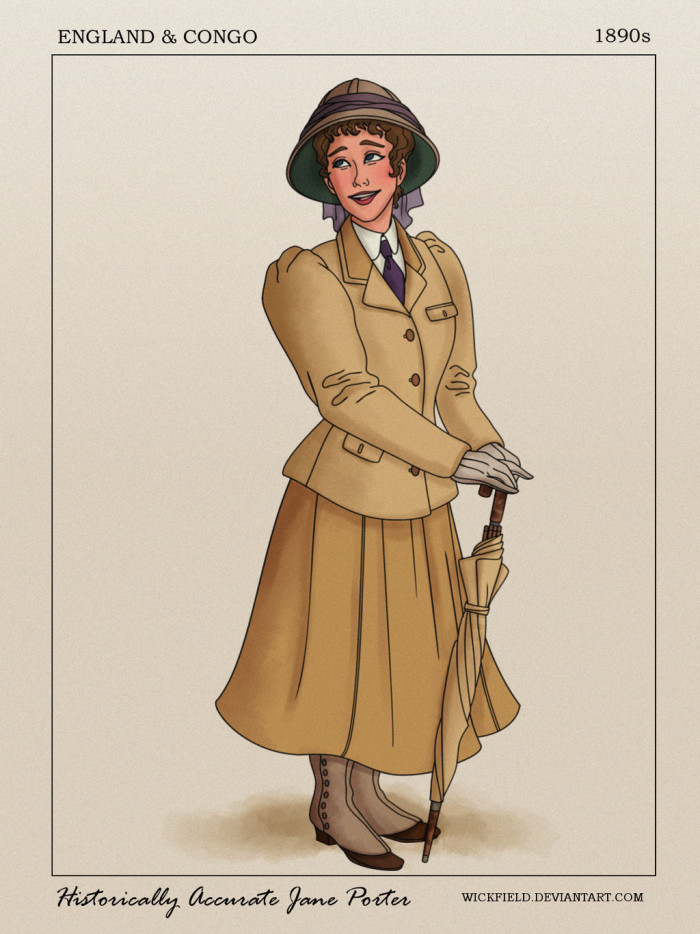 Read More: Historically Accurate Jane Porter
Read More: Historically Accurate Jane Porter2. Moana
"I soon found when doing my research that there are almost no surviving depictions of humans in ancient Polynesian art, so the closest I could come to an authentic portrayal of Moana’s clothing was in the early drawings of pre-contact fashion soon after European discovery."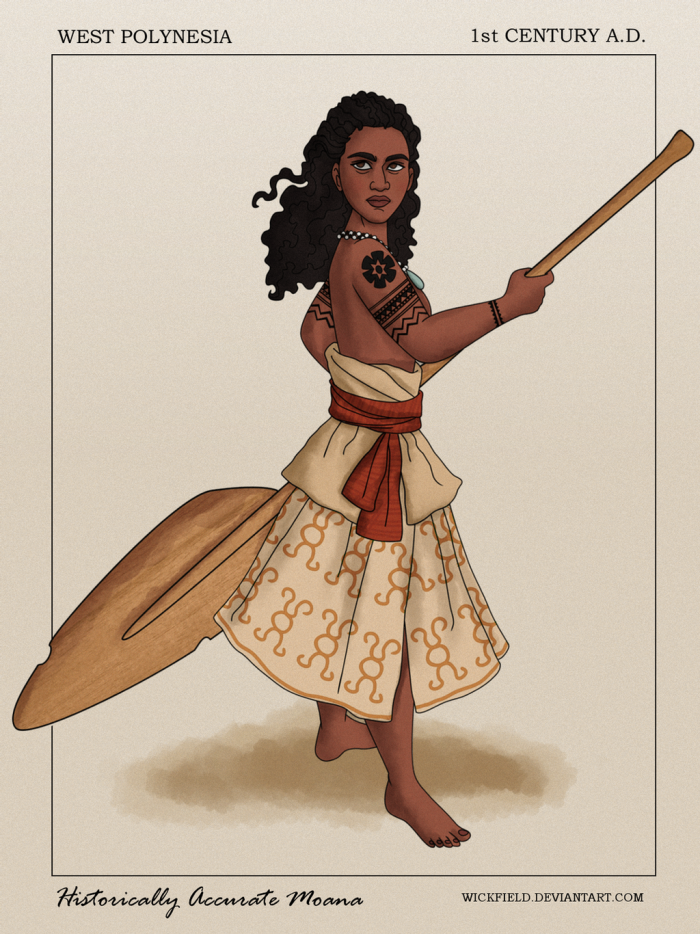 Read More: Historically Accurate Moana
Read More: Historically Accurate Moana3. Frollo, The Hunchback of Notre Dame
"I learned that while Frollo could have been a minister of justice, he couldn't be the Minister of Justice, because that wasn't any kind of real title at the time. In the Old Regime, prior to the French Revolution, Frollo would have been called the Lord Chancellor of France or the Keeper of the Seals, which is the equivalent of the modern Minister of Justice. Just a fun fact."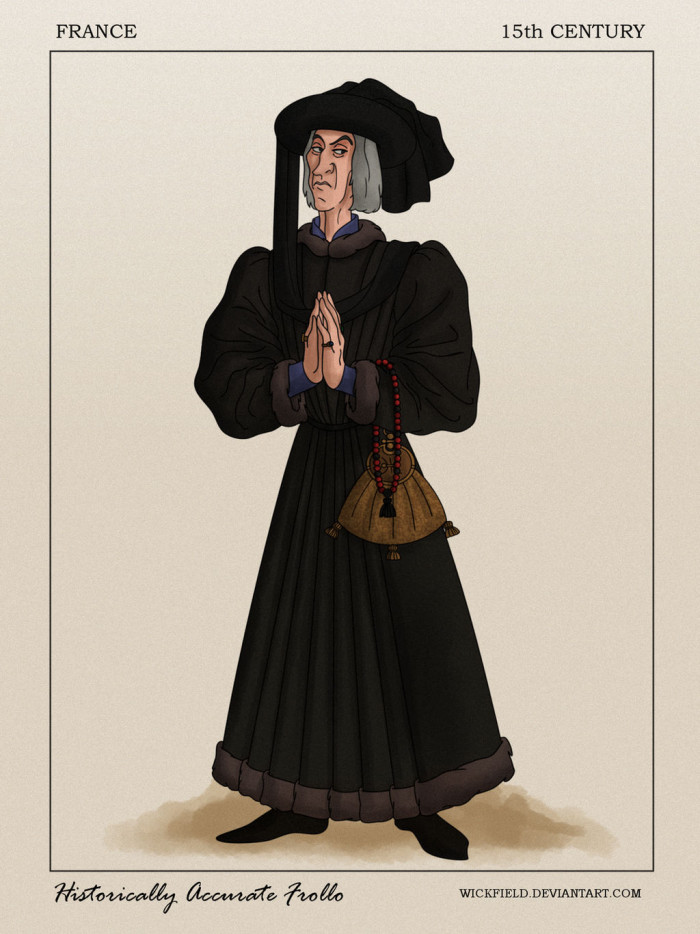 Read More: Historically Accurate Frollo
Read More: Historically Accurate Frollo4. Li Shang, Mulan
"Shang’s outfit was mainly inspired by these tworeconstructed officer costumes, which are similar to these examples of Han clothing from a Chinese military book. I made Shang’s tunic red to evoke the look of his cape in the movie – despite what films portray I didn’t find any evidence that the Chinese wore capes during this period, but the long tunic adds some elegance and drama."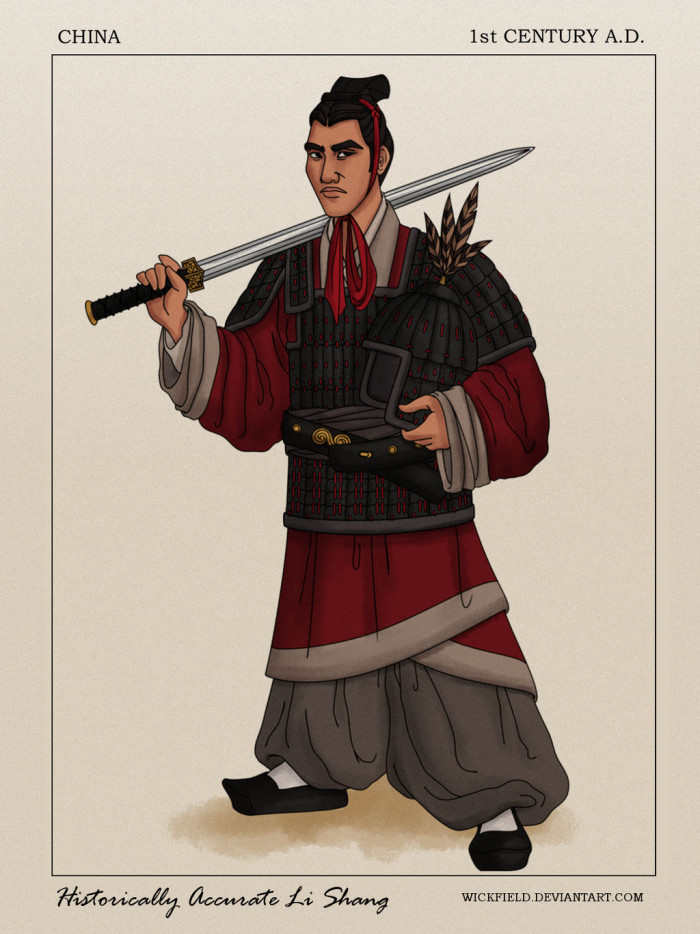 Read More: Historically Accurate Li Shang
Read More: Historically Accurate Li Shang5. Anna, Frozen
"In doing Anna’s historical outfit, I wanted to mimic the costume in the movie with pieces that actually existed in Norway at the time. Modern bunads are known for having lots of regional differences, with each region having their own design, and fortunately my main 19th century reference, Johannes Flintoe, worked in areas like Sogn og Fjordane and Hordaland, the same areas that influenced Disney’s design of Arendelle in the movie – talk about lucky! This way I could be both period-accurate and reasonably regionally-accurate as well, at least as much as you can be for a fictional location."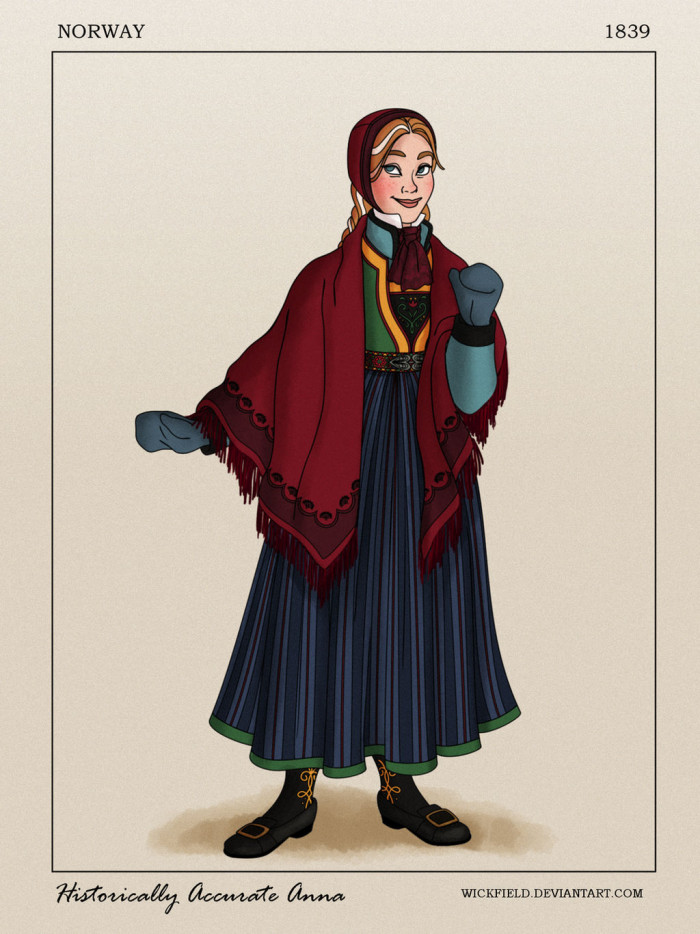 Read More: Historically Accurate Anna
Read More: Historically Accurate Anna6. Wendy, Peter Pan
"Since nightgowns in this time period were almost universally white for ease of cleaning, I added the bits of blue from her original design in her ribbons and her bedroom slippers, which were a typical Edwardian design."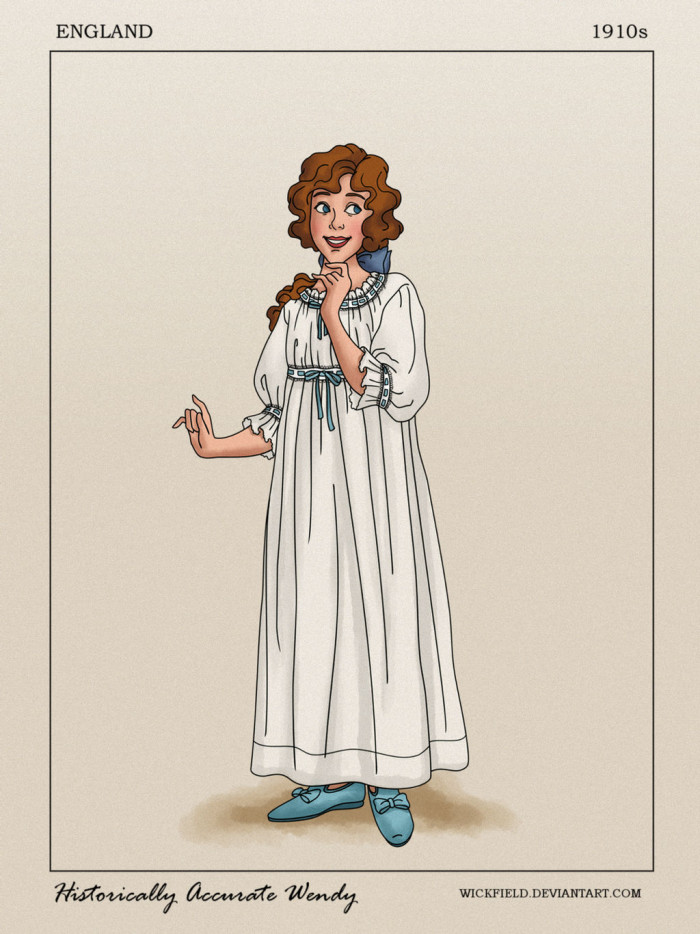 Read More: Historically Accurate Wendy
Read More: Historically Accurate Wendy7. Phoebus, The Hunchback of Notre Dame
"In real 1480s France, someone like Phoebus would never wear a gold suit of armor. It’s questionable whether gold armor really existed at all – most depictions of gold armor in artwork at the time are purely symbolic, representing royalty or religious figures like archangels. It is possible a ruler might have had ceremonial gilt armor, but even though he is a high-ranking Captain Phoebus would not wear such fancy equipment."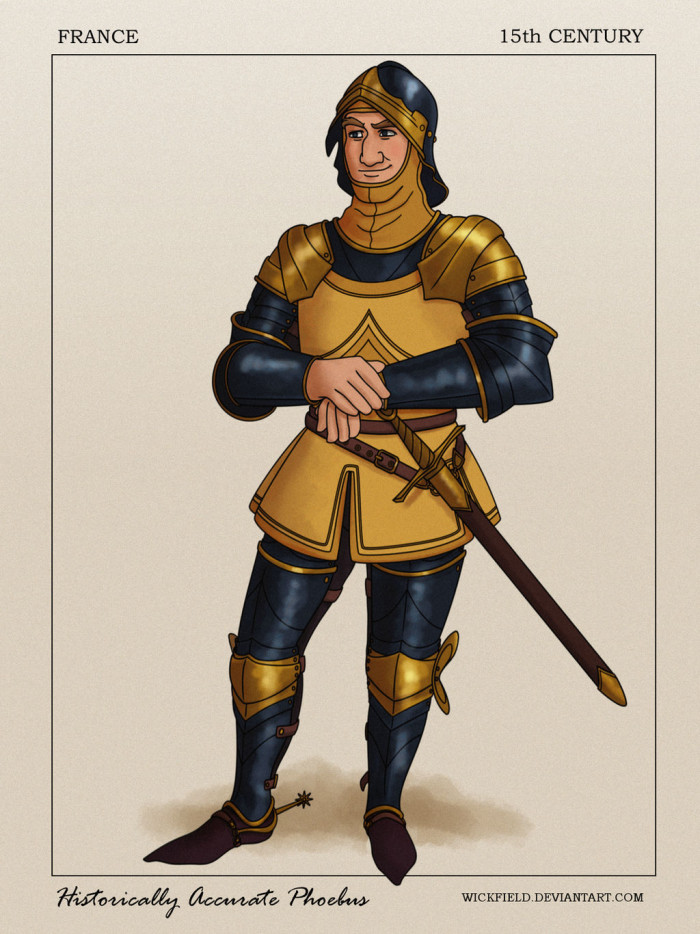 Read More: Historically Accurate Phoebus
Read More: Historically Accurate Phoebus8. Rapunzel, Tangled
"It was still kind of tough to figure out what Rapunzel should wear since 18th century fashion depended heavily on your class, and a girl locked in a tower by a witch doesn’t exactly fit into any one category! However, when I looked at Rapunzel’s outfit she definitely appears to dress more like the Corona royalty than any of the village peasants, so I’m assuming that Gothel enabled her to keep up with the changing fashions…for some reason. "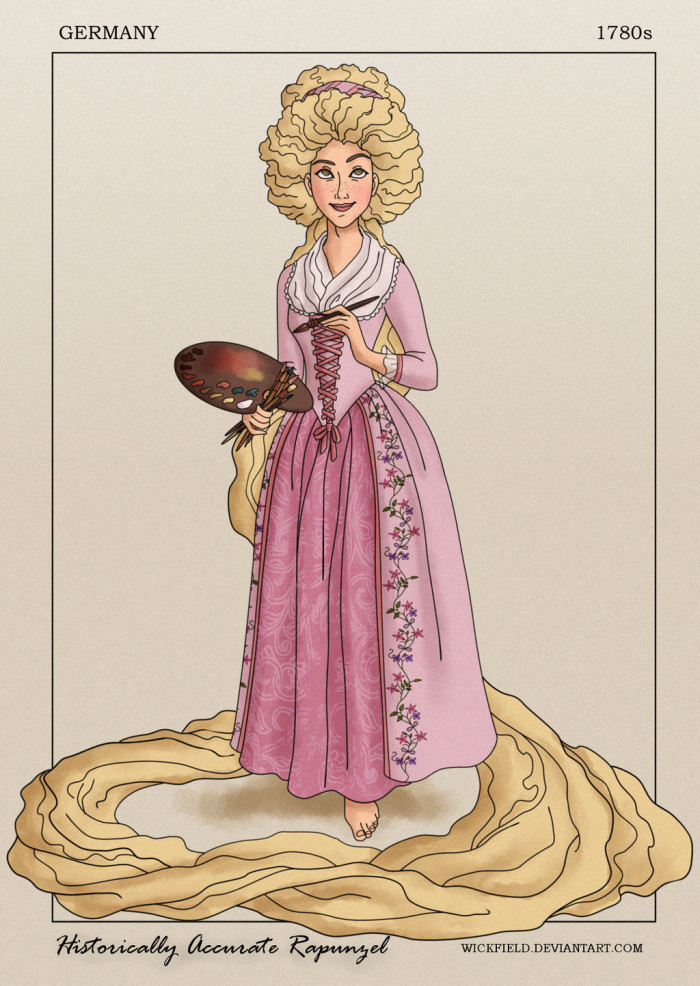 Read More: Historically Accurate Rapunzel
Read More: Historically Accurate Rapunzel
9. Merida, Brave
"Merida's clothing in the movie is in no way from the 10th century - it isn't even Scottish! Both her fancy and casual dresses seem to be based on the pseudo-historical dresses from John William Waterhouse's art. Her casual dress in particular is a 19th century imagining of an Italian style. So I had to fix that right away."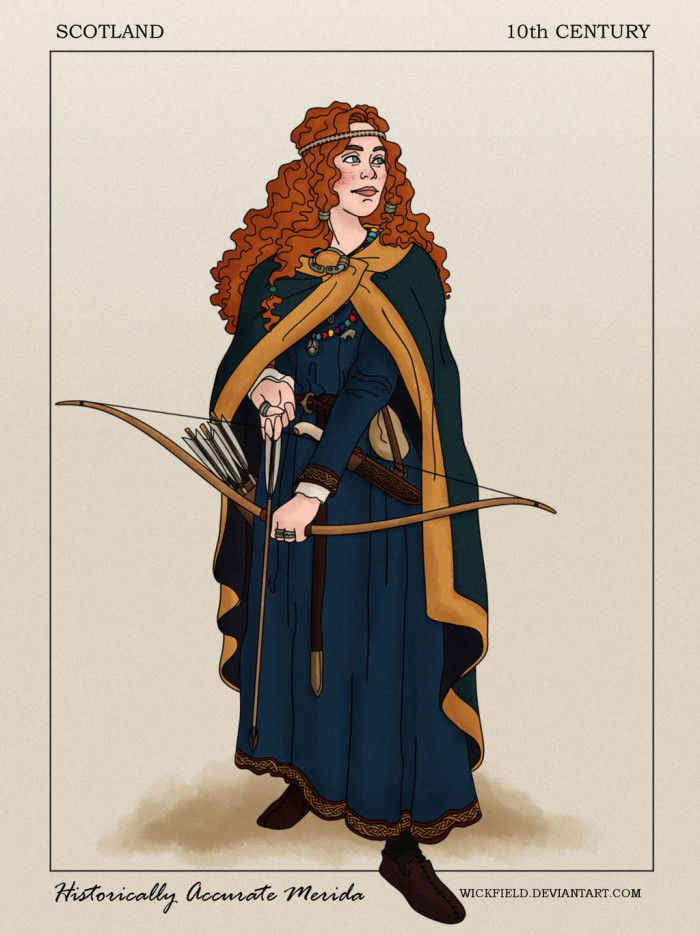 Read More: Historically Accurate Merida
Read More: Historically Accurate Merida
10. Megara, Hercules
"You don’t really see any pink or lavender clothing in Mycenaean artwork – they probably could have worn it, since they had access to madder dyes, but for a more authentic look I decided to take some artistic license and give Meg a blue dress with black stripes, since blue shows up all the time in Mycenaean art. Black is the color that represented Hades in real-life Greek mythology, and obviously Hades’ realm was blue in the movie, so I thought it was an appropriate combo considering she “serves” him. I left in the orange stripes to add a little warmth and show Meg is not part of the underworld yet!"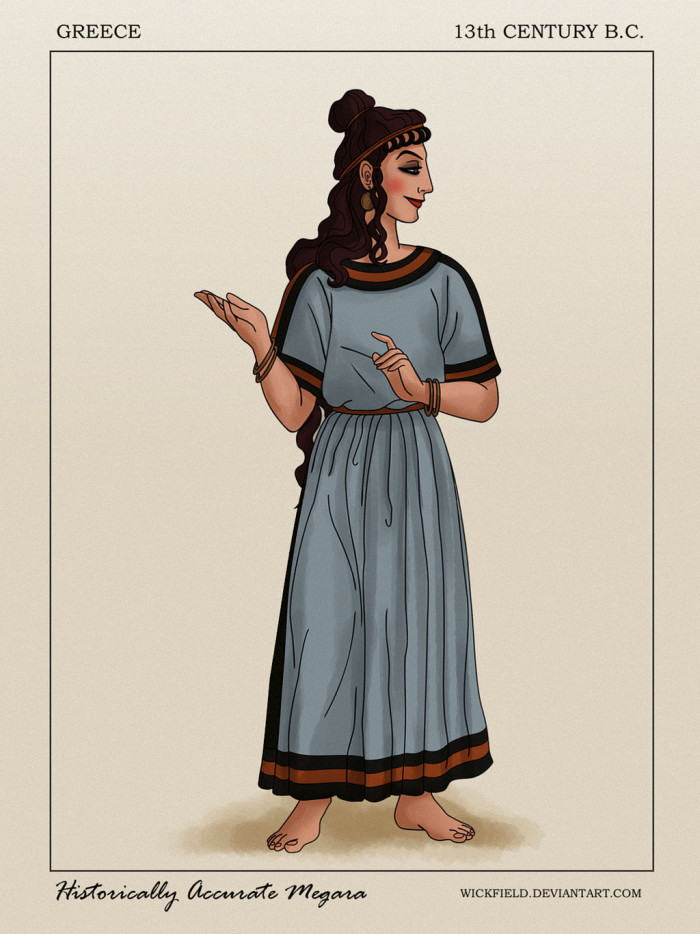 Read More: Historically Accurate Megara
Read More: Historically Accurate Megara
11. Jafar, Aladdin
"As a man of status he would have been very well dressed, obviously. I drew Jafar in the typical loose Arab robe, with red lined sleeves, a knotted belt and a matching pair of boots. Interestingly, black was a fashionable color in the Abbasid court, to the point that their neighbors in China and Byzantium called them "the black-robed ones". As a mark of prestige it was often worn for ceremonial occasions and by men of the higher ranks, and it is a color often depicted in Arab art."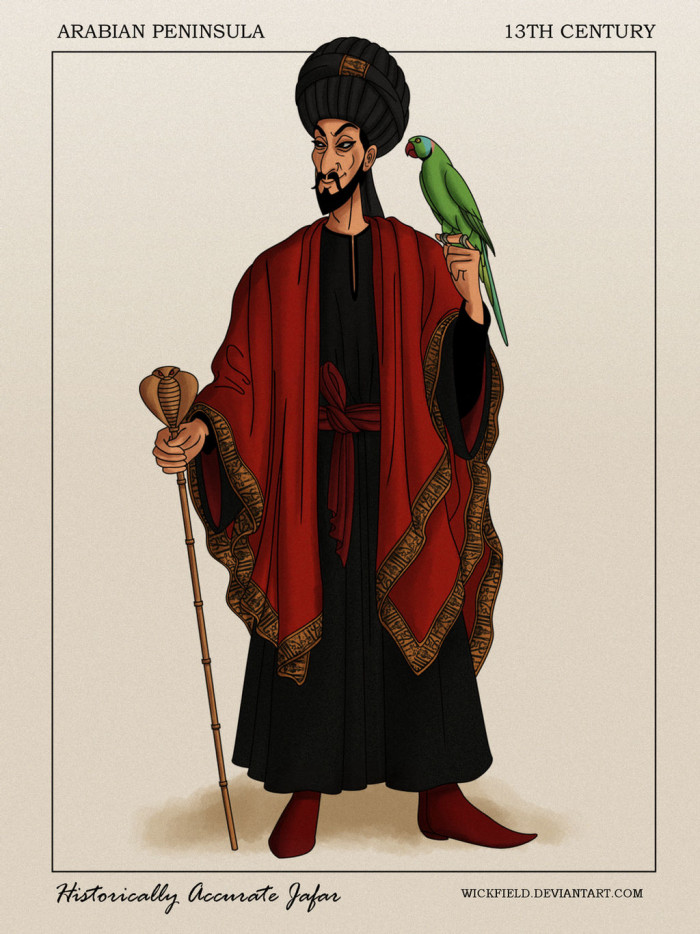 Read More: Historically Accurate Jafar
Read More: Historically Accurate Jafar
12. Aladdin
"Interestingly, because of trade and cultural influence, it was not all that different from European clothing at the time. Many men wore long tunics that were about calf or ankle-length, but working men were shown wearing shorter tunics sometimes without pants but more often with a looser, baggier version of the salwar. I didn't see any examples of purple clothing on these lower class men, only on more regal figures, although many of the laborers were wearing tunics of other colors. Since I know that indigo was a widely used dye in this region, I decided to give Aladdin a dull indigo tunic to resemble his original vest, tied with a narrow belt which was apparently more typical than a sash, at least among average men."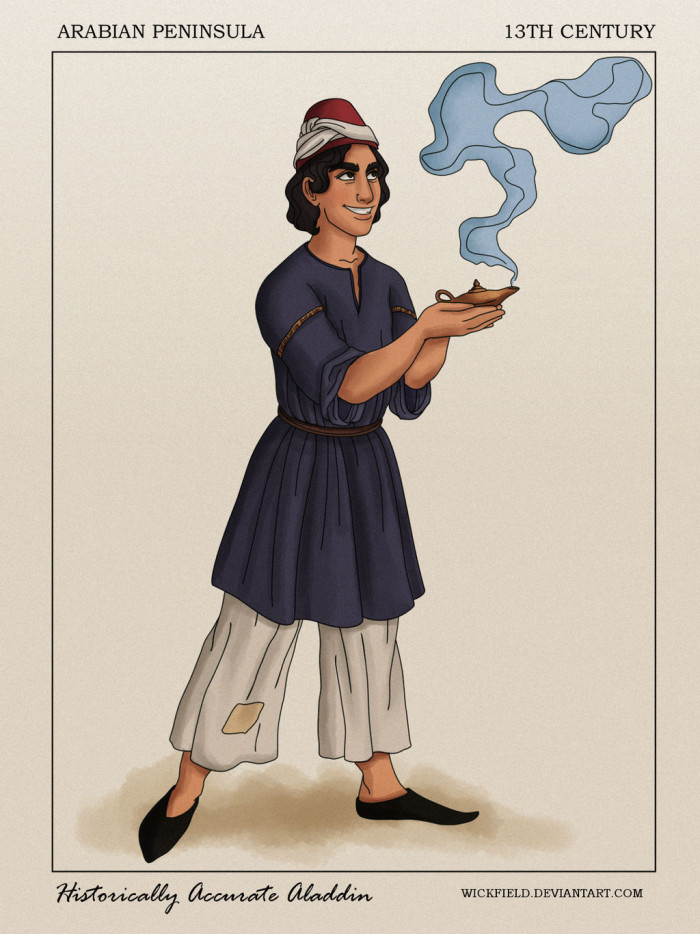 Read More: Historically Accurate Aladdin
Read More: Historically Accurate Aladdin
13. Gaston, Beauty and the Beast
"Since Gaston is known for his hunting abilities, I chose to dress him in clothing that would actually be appropriate for his favorite hobby. Most depictions of hunting from 18th century Europe show nobility doing formal hunting in fancy clothing, not the kind a country man like Gaston would do, so I started by looking at depictions from America to get a better feel for what a how a rustic hunter would dress."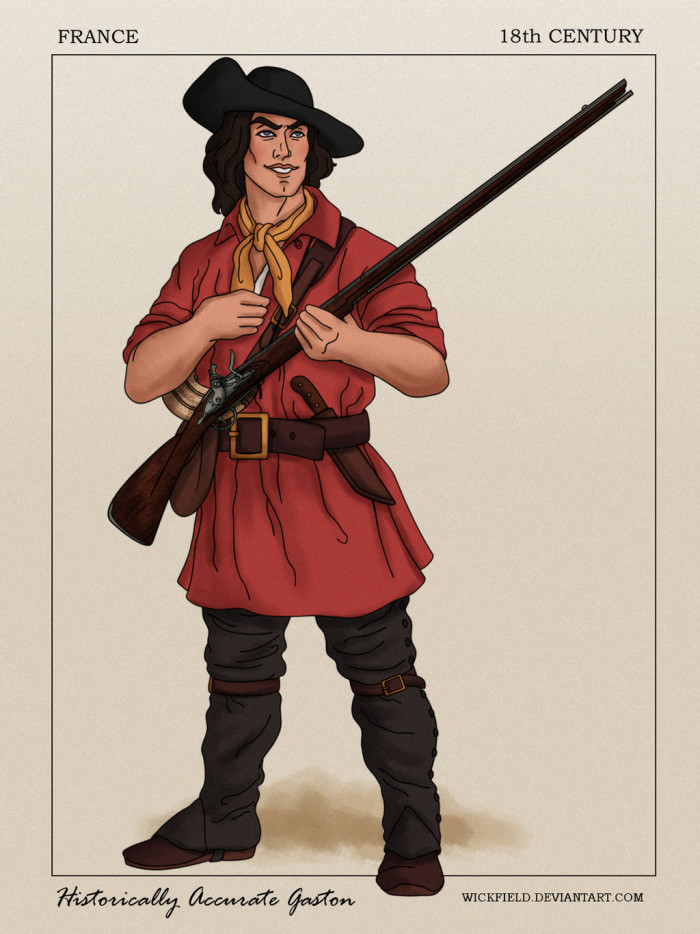 Read More: Historically Accurate Gaston
Read More: Historically Accurate Gaston
14. Snow White, Snow White and the Seven Dwarfs
"I knew from the beginning that I wanted to represent Snow White in lower-class clothing rather than the wealthy fashion she would wear as a princess. Since the Queen forces Snow White to work as a maid I think it would be very unlikely Snow would have an elaborate Cranach gown in her wardrobe, even for her day out of the castle. " Read More: Historically Accurate Snow White
Read More: Historically Accurate Snow White
15. Milo Thatch, Atlantis
"I’m assuming Milo originally comes from a somewhat wealthy family since he was able to go to Oxford and since his grandfather was a world traveler with millionaire friends. At the very least he would be upper middle class and as such, he would be a well-bred young man. During this time your clothing and behavior was largely influenced by your social circle and upbringing, so Milo would never dress as sloppily as he does in the film, nerdy or otherwise."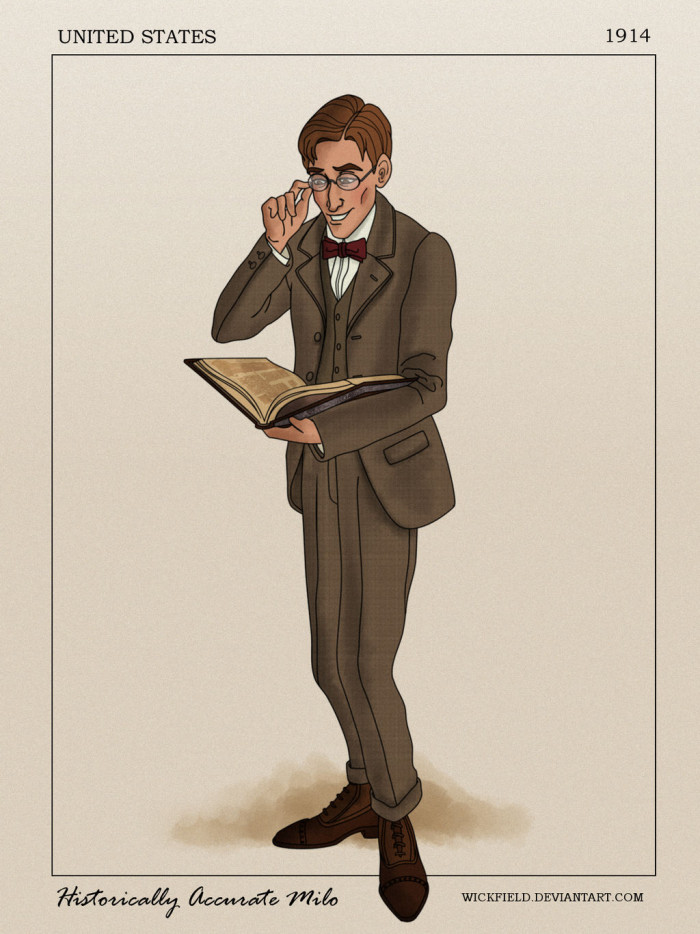 Read More: Historically Accurate Milo
Read More: Historically Accurate Milo
16. Esmerelda, The Hunchback of Notre Dame
"Almost every single historical depiction of the Romani show the women wearing a turban-like headdress (even female children wear this covering), and some kind of cape or blanket draped over their dress. Apparently those garments were pretty much mandatory, so Esmeralda has to wear them here!"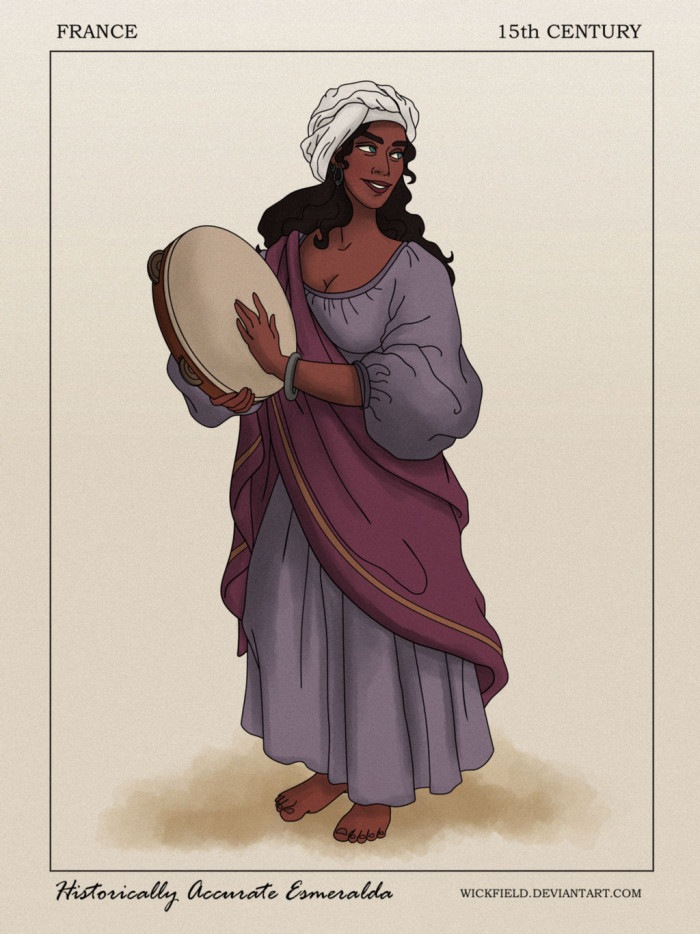 Read More: Historically Accurate Esmerelda
Read More: Historically Accurate Esmerelda
17. Jasmine, Aladdin
"When I discovered the 13th century illustrations by Al-Wasiti and Al-Jaziri, I was able to learn a lot about the kind of fashions an Arabian princess could have worn. I wanted to draw Jasmine in an outfit she could wear for the majority of the film, and since she spends most of the film with male characters like Jafar or Aladdin, her outfit would need to be of the more modest variety, since Muslim women were required to dress differently around men they could possibly marry." Read More: Historically Accurate Jasmine
Read More: Historically Accurate Jasmine
18. Mulan
"It is unlikely that Mulan would have cut her hair in the way she did in the movie. Confucianism dictated that adult men and women needed to let their hair grow as a demonstration of "filial piety." Men would have kept their hair long like a woman's, but they wore it in a topknot, so in order to blend in as a soldier Mulan would have only had to wear a topknt. Cutting your hair was a punishment and no one would have done it voluntarily! To mimic her shorter hairstyle in the movie, I referenced the hairdo worn by some of the female statues."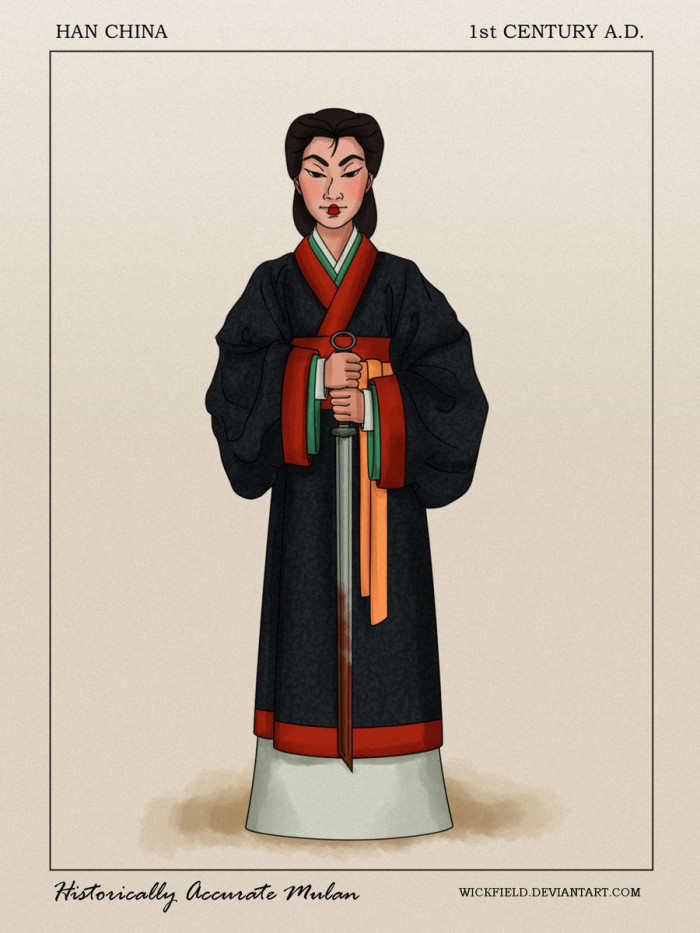 Read More: Historically Accurate Mulan
Read More: Historically Accurate Mulan
19. Hans, Frozen
"Although it was for just a brief time, a man's figure was almost as artificial as a woman's in the 1830s. Fashionable men had broad shoulders and chests (usually assisted by padding in their coats), and sometimes even cinched their waists with male corsets! I doubt a trim young man like Hans would take such measures, but his waistcoat would have hit at the waist to create a similar visual effect, and it would have been tightly cut to keep him looking as slim as possible."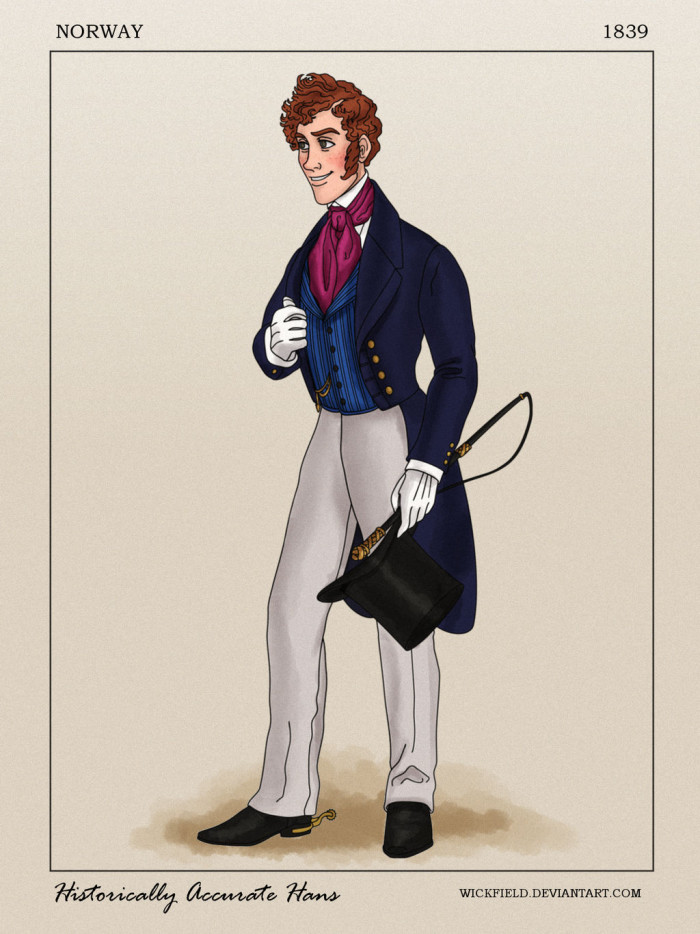 Read More: Historically Accurate Hans
Read More: Historically Accurate Hans
20. Hercules
"It is apparently supposed to be occurring in a timeline soon after the Trojan War, since the Disney version of Philoctetes (who is mortal) trained heroes like Achilles and Odysseus (in the TV series Hercules also went to school with Helen of Troy and Cassandra). This actually fits in fairly nicely with the “historical” periods when some scholars suggest Hercules/Herakles would have lived, in the 13th century BC. So like a lot of Hollywood “Greek” movies, there is a completely Classical-style art design, with a Bronze Age story – the historic equivalent of dressing the Egyptians in medieval fashion."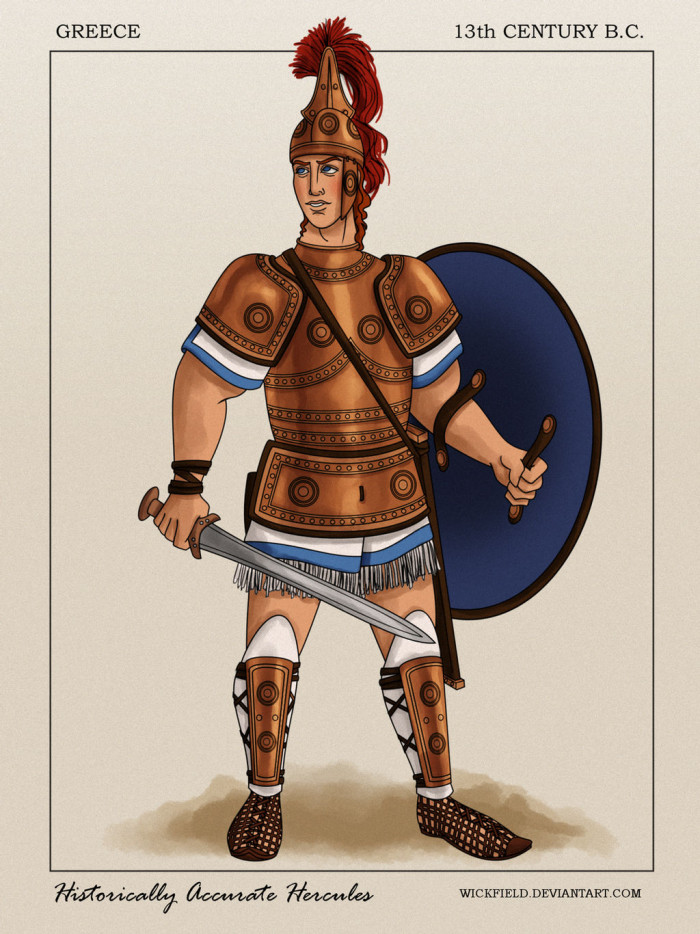 Read More: Historically Accurate Hercules
Read More: Historically Accurate Hercules
21. Kuzco, The Emperor's New Groove
"The Sapa Inca’s followers practically worshipped him and he had the best of everything, including clothing. All Incan men wore woven tunics, but while peasants' clothes were made of llama wool, the emperor would have tunics made of fine vicuna wool dyed bright colors, like cochineal red which is made from the skin of an insect."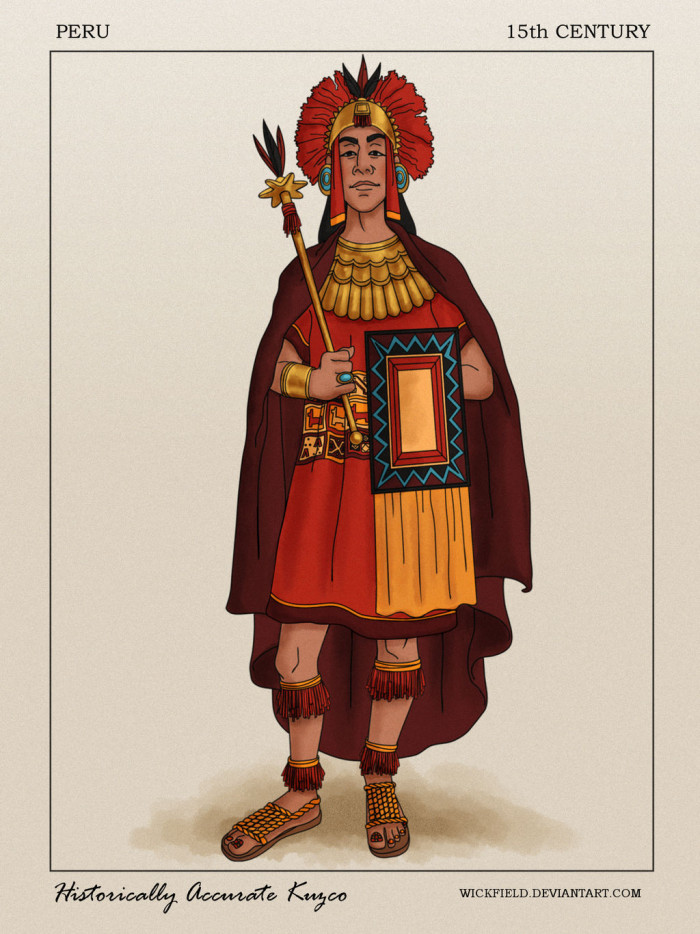 Read More: Historically Accurate Kuzco
Read More: Historically Accurate Kuzco
22. Kristoff, Frozen
"According to Disney, Kristoff is a member of the Sami, an indigenous people who live in an area called "Sapmi" which includes parts of Norway, Sweden, Russia, and Finland. Despite a history of discrimination the Sami still hold on to many of their traditions today, and one way this is reflected is in their clothing. Sami clothing still greatly resembles what Kristoff's people wore in the 19th century, and like the Norwegian bunad there are lots of regional differences."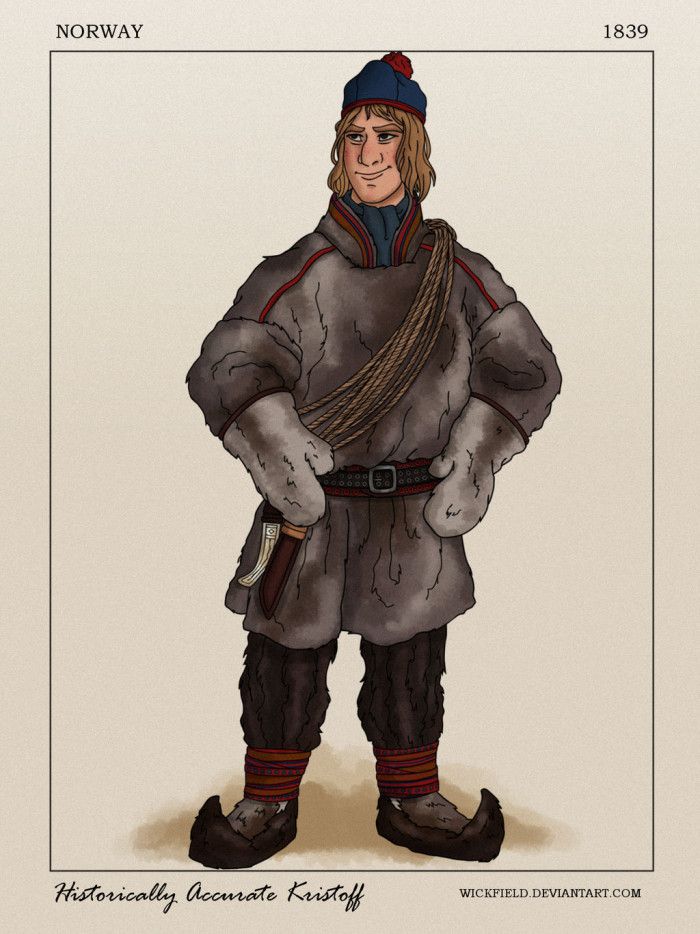 Read More: Historically Accurate Kristoff
Read More: Historically Accurate Kristoff
23. Flynn Rider, Tangled
"Because the people they robbed were wealthy, highwaymen were often pretty well off and could have kept up with the styles reasonably well. I drew Flynn wearing the waistcoat and breeches of the late 1770s/early 1780s style, a slightly slimmer cut than earlier years. I decided to give his coat some of the elements of his vest in the movie including the color and high collar."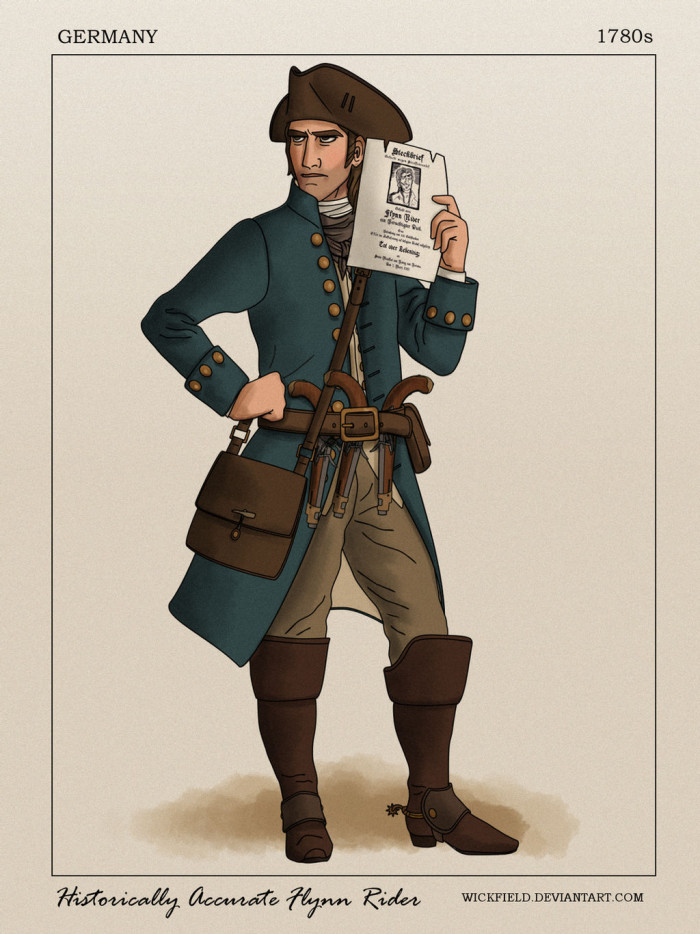 Read More: Historically Accurate Flynn Rider
Read More: Historically Accurate Flynn Rider
24. Queen Elsa, Frozen
"While most Victorian fashion has a prudish reputation, that was certainly not the case for evening wear, which was allowed to be daring. A girl like Elsa would never wear long sleeves for a formal occasion, even though she would always wear them during the day. Luckily for me, though, gloves were definitely still in style for evening wear, and at this point in the movie Elsa is not Elsa without her gloves."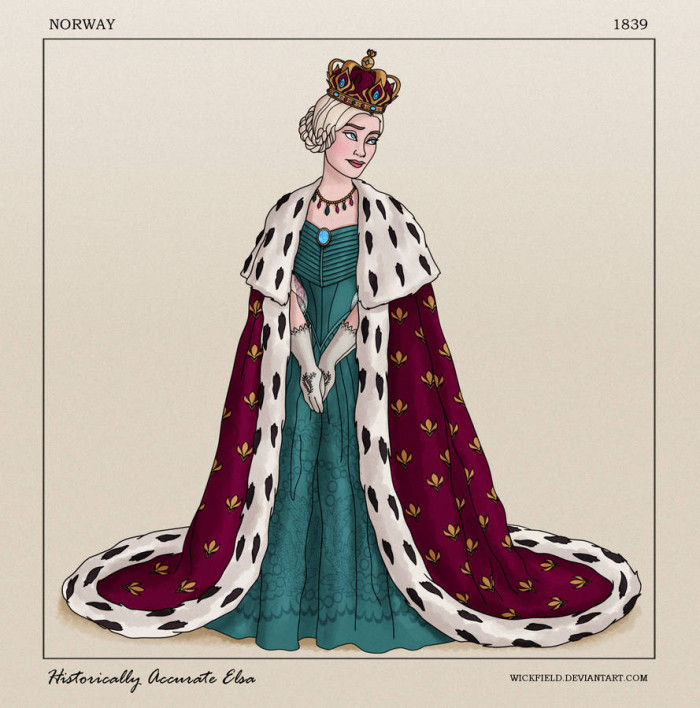 Read More: Historically Accurate Elsa
Read More: Historically Accurate Elsa
25. Belle, Beauty and the Beast
"I studied lots of paintings of “rural” life for inspiration for Belle’s blue dress. At this point in history, social status really dictated what kinds of clothing you would wear. In Disney’s version, Belle’s father would be a laborer or a tradesman, a member of the working class, so Belle would wear working class clothing as well."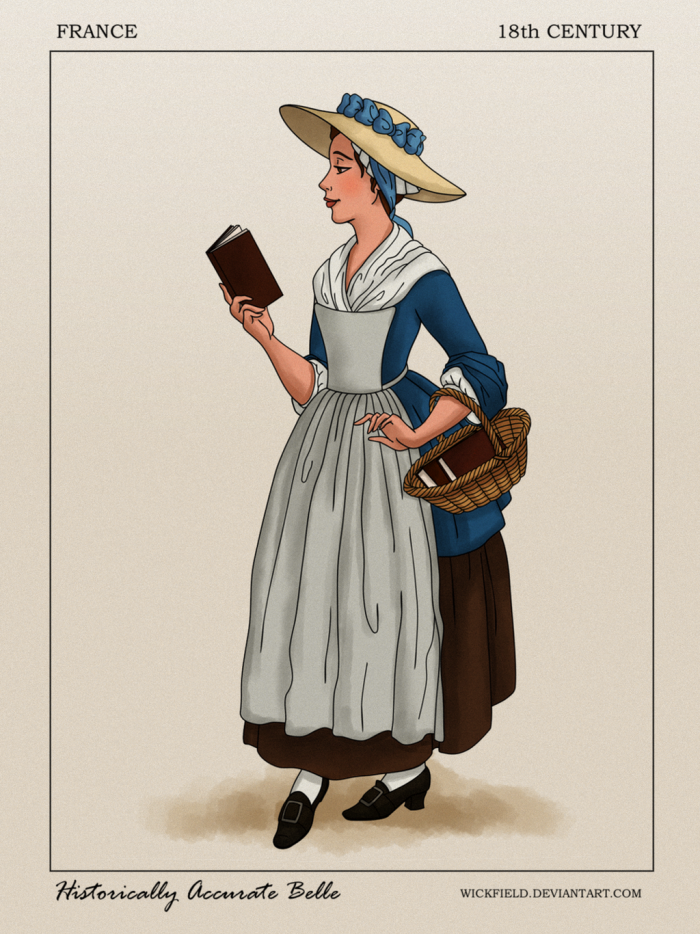 Read More: Historically Accurate Belle
Read More: Historically Accurate Belle




